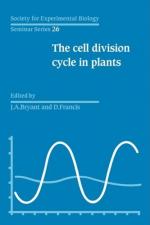|
This section contains 1,671 words (approx. 6 pages at 300 words per page) |

|
The cell cycle is the process by which a cell grows, duplicates its DNA, and divides into identical daughter cells. Cell cycle duration varies according to cell type and organism. In mammals, cell division occurs over a period of approximately twenty-four hours.
In multicellular organisms, only a subset of cells go through the cycle continuously. Those cells include the stem cells of the hematopoietic system, the basal cells of the skin, and the cells in the bottom of the colon crypts. Other cells, such as those that make up the endocrine glands, as well as liver cells, certain renal (kidney) tubular cells, and cells that belong to connective tissue, exist in a nonreplicating state but can enter the cell cycle after receiving signals from external stimuli. Finally, postmitotic cells are incapable of cell division even after maximal stimulation, and include most neurons, striated muscle cells, and...
|
This section contains 1,671 words (approx. 6 pages at 300 words per page) |

|


